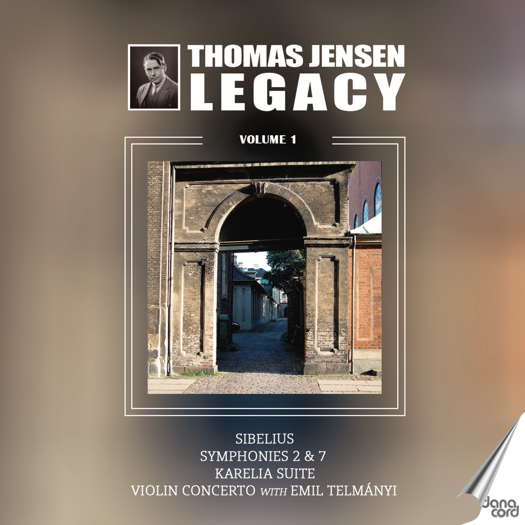 SPONSORED: CD Spotlight. Beautifully Apt - Choral music by Herbert Howells, heard by Robert Anderson.
SPONSORED: CD Spotlight. Beautifully Apt - Choral music by Herbert Howells, heard by Robert Anderson.
All sponsored features >>

Music of the Utmost Beauty and Originality
GERALD FENECH listens to Thomas Jensen conducting music by Jean Sibelius
'... full of fire, passion and, above all, authority ...'
Jean Sibelius (1865-1957) was a Finnish composer and violinist of the late Romantic and early modern periods. He is widely recognized as his country's greatest composer, and his music is often credited with having helped Finland develop a national identity during its struggle for independence from Russia. The core of his output is his set of seven symphonies which, like his other major works, are regularly performed and recorded in his native country, and very many others. His other best-known compositions are Finlandia, the Karelia suite, Valse Triste, the Violin Concerto, the Choral Symphony Kullervo and The Swan of Tuonela. Other well known works include pieces inspired by nature, Nordic mythology and the Finnish national epic, the Kalevala, over one hundred songs, incidental music for several plays, twenty-one publications of choral music and Masonic ritual music.
Sibelius composed prolifically until 1926, but after the tone poem Tapiola he stopped writing altogether. Indeed, up to his death in September 1957 only silence came out of his pen. No one really knows what was the reason for this perplexing decline, and the 'Silence of Jarvenpaa', the location of his home, is still an unsolved mystery. Whatever the case, Sibelius composed music of the utmost beauty and originality, and we should be thankful that his oeuvre is so varied and substantial. So why not revel in it and stop speculating about those last thirty years?
The Second symphony, an evergreen favourite, was premiered by the Helsinki Philharmonic Society on 8 March 1902, with the composer conducting. The opening chords with their rising progression provide a motif for the whole work, while the heroic theme of the finale is absolutely gripping. After this premiere Sibelius was declared a national hero and a guiding light against Russian oppression.
Listen — Sibelius: Finale (Symphony No 2)
(CD1 track 4, 17:05-17:58) ℗ 2021 Danacord Records :
The Seventh in C was the composer's last published symphony. Completed in 1924, it is notable for having a single movement. It has been described as completely original in form, subtle in its handling of tempi, individual in its treatment of key and wholly organic in growth. Considered to be Sibelius' most remarkable composition, it was initially titled Fantasia Sinfonica; later it became his Seventh Symphony. The premiere took place in Stockholm in March 1924 and Sibelius himself conducted. It was based on an adagio movement he had sketched some ten years earlier. In general the work is dominated by the strings, but there is also a distinctive trombone theme that makes its mark.
Listen — Sibelius: Symphony No 7
(CD1 track 5, 10:42-11:38) ℗ 2021 Danacord Records :
The 'Four Legends' were composed in the early 1890s. Originally conceived as a mythological opera on a scale matching those of Wagner, Sibelius later changed his musical vision and the work became an orchestral piece in four movements. The work is also known as the Lemminkäinen Suite and is based on this character from the Finnish national epic, the Kalevala.
Listen — Sibelius: Lemminkäinen's Return (Four Legends from the Kalevala)
(CD2 track 7, 4:37-5:28) ℗ 2021 Danacord Records :
The 'Karelia' Music, one of the composer's earlier works written for the Vybord Students Association, was first performed on 13 November 1893 to a noisy audience. Later the piece was published as the Karelia Suite, Op 11, and is in four movements. It remains one of Sibelius' greatest hits.
Listen — Sibelius: Alla marcia (Karelia Suite)
(CD1 track 8, 1:34-2:28) ℗ 2021 Danacord Records :
The Violin Concerto in D minor was premiered on 8 February 1904 with Victor Novacek as soloist. The performance was a disaster mainly for two reasons: Sibelius had barely the time to finish the piece within the planned timeframe and the soloist had insufficient time to prepare the piece for execution. After substantial revisions, the new version was performed on 19 October 1905 with none other than Richard Strauss conducting. Karel Halir, the Berlin Court Orchestra's leader, was the soloist. The performance was a tremendous success, and this magical concerto has remained in the repertoire ever since.
Listen — Sibelius: Allegro ma non tanto (Violin Concerto)
(CD2 track 3, 6:39-7:34) ℗ 2021 Danacord Records :
Thomas Jensen (1898-1963) was to Sibelius what Bruno Walter was to Mahler. Indeed, Jensen was so familiar with the composer's works, not only because he was a contemporary, but also because he played in Sibelius' orchestra between 1924 and 1926. These recordings made between 1952 and 1963 reveal Jensen's love for this quite exceptional music with performances full of fire, passion and, above all, authority, and despite many other eminent conductors having given us other exciting versions, Jensen's will remain the benchmark. Unmissable stuff for the ages.
Copyright © 13 January 2022
Gerald Fenech,
Gzira, Malta

CD INFORMATION: THOMAS JENSEN LEGACY VOLUME 1
CLASSICAL MUSIC ARTICLES ABOUT FINLAND



